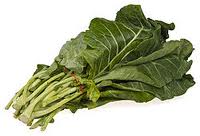 Collards, also known as tree cabbage, is a bright green vegetable typical of Southern cooking. Rich in vitamins and minerals, collards grow well in the southern states but can tolerate temperatures typical of southern Canada. Easy to grow and maintain, collards make a great addition to any home garden. The outer surface of this leafy vegetable can be quite waxy, so it’s important to cook this vegetable for a long period of time to assure the maximum nutrition intake. Beneath the dark green color, collards include an excellent source of beta carotene, vitamin A, vitamin C and calcium. The darker the leaf the more beta carotene provided.
Collards, also known as tree cabbage, is a bright green vegetable typical of Southern cooking. Rich in vitamins and minerals, collards grow well in the southern states but can tolerate temperatures typical of southern Canada. Easy to grow and maintain, collards make a great addition to any home garden. The outer surface of this leafy vegetable can be quite waxy, so it’s important to cook this vegetable for a long period of time to assure the maximum nutrition intake. Beneath the dark green color, collards include an excellent source of beta carotene, vitamin A, vitamin C and calcium. The darker the leaf the more beta carotene provided.
Key Nutrients
Collard greens are an excellent source of vitamin B6, vitamin C, carotenes, chlorophyll and manganese. Collard greens provide a high amount of iron, copper and calcium. Finally, collard greens are a wonderful source of fiber.
Health Benefits
Beta Carotene – Beta carotene has been well-studied as a dietary antioxidant. Carotenoids are also thought to benefit eye health. Some studies support a role of carotenoids in reducing macular degeneration.
Vitamin C – Regular consumption of foods rich in vitamin C helps the body develop resistance against infections and scavenges harmful, pro-inflammatory free radicals. Vitamin C also helps to prevent respiratory problems such as asthma and lung cancer. Vitamin C has been shown to lower blood pressure, and therefore lessen the probability of hypertension.
Vitamin B6 – Vitamin B6 helps to keep your immune system in good working order. It aids in the breakdown of fats, carbohydrates and amino acids while helping to maintain the health of lymph nodes. Additionally, vitamin B6 helps to regulate blood glucose levels.
Manganese – Manganese aids in the metabolism of food as well as promotes normal functioning of the nervous system. Manganese works as an antixoidant to help prevent cancer and heart disease.
Season
Collars mature in the Fall, and are generally available throughout the wintertime.
Nutrition Information
Per 1 Cup (36 grams):
Calories (cKal): 11
Protein (grams): .88
Total Fat (grams): .15
Carbohydrates (grams): 2.05
Fiber (grams): 1.3
Buying and Storing
When buying collards, make sure they are free from lots of holes, which typically indicates insect infestation. The leaves should also be bright green and free from yellow hues. When storing at home, its important to keep the greens in a sealed bag, which will help to extend its life to up to one week.
Best Way to Add to Diet
Collard greens can be very dirty, so make sure to wash the greens under cold water for at least one minute. Once washed, it’s a good idea to cut the greens into smaller pieces to assure they cook quickly and evenly. Make sure to remove the inner stems which tend to be very rough and bitter. Its important to cook the greens for a long period of time to make assure they are easily chewable and supply the maximum amount of nutrition.
Collard Green Recipe

 Not Sure What Healthy Foods To Eat?
Not Sure What Healthy Foods To Eat? This week we take a look at one of my favorite healthy foods...the mighty Avocado.
This week we take a look at one of my favorite healthy foods...the mighty Avocado.
No comments yet.